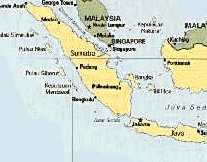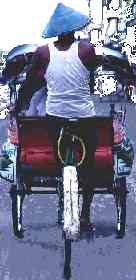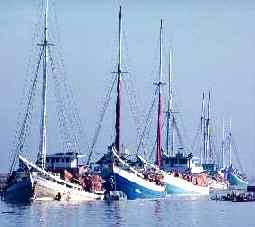|
|
LEG
|
NAUTICAL
MILES
|
BUNKERING
|
WAYPOINT
|
SUNSHINE
DAYS
|
|
-
|
-
|
-
|
-
|
-
|
|
|
-
|
-
|
-
|
-
|
|
-
|
-
|
FILL
UP
|
Gibraltar
|
00.00
|
|
1
|
729
|
-
|
Tenerife,
Canary Islands
|
1.90
|
|
2
|
3,154
|
-
|
Trinidad,
Port of Spain
|
8.21
|
|
3
|
1,182
|
1
|
Panama
City
|
3.00
|
|
4
|
970
|
-
|
Galapagos
|
2.45
|
|
5
|
3,640
|
-
|
Tahiti
|
9.48
|
|
6
|
1,423
|
-
|
Tonga,
Nukualofa
|
3.71
|
|
7
|
410
|
-
|
Fiji,
Suva
|
1.07
|
|
8
|
1,886
|
1
|
Port
Moresby PNG
|
4.91
|
|
9
|
340
|
-
|
Thursday
Island, Cape York
|
0.88
|
|
10
|
724
|
-
|
Darwin
|
1.89
|
|
11
|
1,572
|
-
|
Jakarta,
Indonesia
|
4.09
|
|
12
|
1,881
|
-
|
Colombo,
Sri Lanka
|
4.90
|
|
13
|
2,109
|
1
|
Aden,
Yemen
|
5.49
|
|
14
|
698
|
-
|
Jeddah,
Saudi Arabia
|
1.82
|
|
15
|
670
|
-
|
Port
Said, Egypt
|
1.75
|
|
16
|
1,111
|
-
|
Palermo,
Sicily
|
2.89
|
|
17
|
170
|
-
|
Naples,
Italy
|
0.44
|
|
18
|
940
|
|
Gibraltar
|
2.45
|
|
-
|
-
|
-
|
-
|
-
|
|
-
|
23,609
|
-
|
RUNTIME
DAYS @ 12.5kts
|
78.70
|
|
-
|
-
|
(ADD
3 DAYS)
|
RUNTIME
DAYS @ 13kts
|
75.67
|
|
-
|
-
|
-
|
-
|
-
|
|
-
|
-
|
(ADD
4 DAYS)
|
14
KNOTS AVE INC
|
70.26
|
|
-
|
-
|
-
|
AT
15 KNOTS AVE
|
65.58
|
|
-
|
-
|
-
|
AT
16 KNOTS AVE
|
61.48
|
Jakarta,
the capital city of the Republic of Indonesia, is a special
territory enjoying the status of a province, consisting of
Greater Jakarta, covering an area of 637.44 square km. Jakarta
is the international gateway to Indonesia. Located on the
northern coast of West Java, it is the center of government,
commerce and industry and as such has an extensive
communications network with the rest of the country and the
outside world.
As Indonesia's main gateway, the Soekarno-Hatta
International Airport serves a growing number of international
airlines and domestic flights. Jakarta is a city of contrasts;
the traditional and the modern, the rich and the poor, the
sacral and the worldly, often stand side by side in this
bustling metropolis. Even its population, gathered from all
those diverse ethnic and cultural groups which compose
Indonesia, are constantly juxtaposed as an ever- present
reminder of the national motto; Unity in Diversity.

Sumatra, & Java - Indonesia
Finding
its origin in the small early 16th century harbor town of Sunda
Kelapa, Jakarta's founding is thought to have taken place on
June 22, 1527, when it was re-named Jayakarta, meaning: Glorious
Victory by the conquering Prince Fatahillah from neighboring
Cirebon. The Dutch East Indies Company which captured the town
and destroyed it in 1619, changed its name into Batavia and made
it the center for the expansion of their power in the East
Indies. Shortly after the outbreak of World War
II, Batavia fell
into the hands of the invading Japanese forces who changed the
name of the city into Jakarta as a gesture aimed at winning the
sympathy of the Indonesians. The
name was retained after Indonesia achieved national independence
after the war's end.
The
ethnic Jakartan called "Orang Betawi" speaks Betawi
Malay, spoken as well in the surrounding towns such as Bekasi
and Tangerang. This language has two variations: the
conventional Betawi Malay and the modern Jakarta Malay. While
the first is spoken by the elder people, born and bred in
Jakarta, the second is spoken by the younger generation and
migrants.
Jakarta's
architecture reflects to a large extent the influx of outside
influences which came and has remained in this vital seaport
city. The Taman Fatahillah Restoration Project, begun in the
early 1970s has restored one of the oldest sections of Jakarta
also known as Old Batavia to approximately its original
state. The old Portuguese Church and warehouse have been
rehabilitated into living museums. The old Supreme Court
building is now a museum of fine arts which also houses part of
the excellent Chinese porcelain collection of former Vice
President Adam Malik. The old Town Hall has become the Jakarta
Museum, displaying such rare items as Indonesia's old historical
documents and Dutch period furniture. Its tower clock was
once returned to England to be repaired under its lifetime
guarantee, which up to now has already lasted hundreds of years.
One
of the most interesting tourist attractions is the "Beautiful
Indonesia in Miniature Park" popularly called "Taman
Mini". Built to portray the variety of cultures found
within the many islands contained in the Republic of Indonesia,
this open-air museum comprises the many architectural forms of
arts and traditions of all 27 provinces. It is proof of the
country's motto of Unity in Diversity as well as Freedom of
Religion depicted in the houses of worship built on the grounds.
Jakarta
has preserved its past and is developing for the future.
Skyscrapers in the center of the city are part of a new
look. Modern luxury hotels today cater to the
discriminating visitors. Transport within the city is plentiful.
It should be noted that museums are open daily from 8.00 a.m.
(except Mondays) till 2.00 p.m. on Tuesdays, Wednesdays,
Thursdays and Sundays. On Fridays closing hour is 11.00 a.m. and
on Saturdays at 1.00 p.m.
PLACES
OF INTEREST
The
National Monument
The
National Monument, or "Monas"
as it is popularly called, is one of the monuments built during
the Sukarno era of fierce nationalism. It stands for the
people's determination to achieve freedom and the crowning of
their efforts in the Proclamation of Independence in August
1945. The 137-meter tall marble obelisk is topped with a flame
coated with 35 kg. of gold. The base houses a historical museum
and a hall for meditations. The monument is open to the public
and upon request the lift can carry visitors to the top which
offers a bird's eye view on the city and the sea.
Central
Museum
Established
in 1778 by U.M.C. Rademacher under the auspices of the Batavia
Association of Arts and Sciences, it offers historical,
prehistorical, archaeological and ethnographic aspects of
Indonesia through its extensive collection of artifacts and
relics which date as far back as to the Stone Age. It has one of
the most complete collections of bronzes and ceramics dating
back to the Han, Tang and Ming Dynasties. The Museum has one of
the finest numismatic collections in the world, including cloth
and money which was used on several islands until recently. The
religious art section is filled with statuary and sculpture
salvaged from sites of Hindu, Buddhist and Islamic edifices. Its
collection of cultural instruments, household utensils, arts and
crafts provide an introduction to the life of the various ethnic
groups which populate Indonesia. This museum is popularly known
as Gedung Gajah or "Elephant Building" because of the
stone elephant offered by King Chulalongkorn of Thailand in 187
1, placed on the front lawn of the building.
Indonesia
in Miniature Park
An
extensive park to get a glimpse of the diverseness of the
Indonesian archipelago, it represents Indonesia's 27 provinces
and their outstanding characteristics, reflected most strikingly
in the exact regional architecture of the province. It has its
own orchid garden in which hundreds of Indonesian orchid
varieties are grown. There is also a bird park with a walk-in
aviary, a fauna museum and recreational grounds with a swimming
pool and restaurants. Of special interest here at Taman
Mini is the Museum Indonesia. A richly decorated building in
Balinese architecture, it houses contemporary arts, crafts and
traditional costumes from the different regions of the
country. Open from 9.00 a.m. to 4.00 p.m. daily.
|
LEG
|
NAUTICAL
MILES
|
BUNKERING
|
WAYPOINT
|
SUNSHINE
DAYS
|
|
-
|
-
|
-
|
-
|
-
|
|
|
-
|
-
|
-
|
-
|
|
-
|
-
|
FILL
UP
|
Gibraltar
|
00.00
|
|
1
|
729
|
-
|
Tenerife,
Canary Islands
|
1.90
|
|
2
|
3,154
|
-
|
Trinidad,
Port of Spain
|
8.21
|
|
3
|
1,182
|
1
|
Panama
City
|
3.00
|
|
4
|
970
|
-
|
Galapagos
|
2.45
|
|
5
|
3,640
|
-
|
Tahiti
|
9.48
|
|
6
|
1,423
|
-
|
Tonga,
Nukualofa
|
3.71
|
|
7
|
410
|
-
|
Fiji,
Suva
|
1.07
|
|
8
|
1,886
|
1
|
Port
Moresby PNG
|
4.91
|
|
9
|
340
|
-
|
Thursday
Island, Cape York
|
0.88
|
|
10
|
724
|
-
|
Darwin
|
1.89
|
|
11
|
1,572
|
-
|
Jakarta,
Indonesia
|
4.09
|
|
12
|
1,881
|
-
|
Colombo,
Sri Lanka
|
4.90
|
|
13
|
2,109
|
1
|
Aden,
Yemen
|
5.49
|
|
14
|
698
|
-
|
Jeddah,
Saudi Arabia
|
1.82
|
|
15
|
670
|
-
|
Port
Said, Egypt
|
1.75
|
|
16
|
1,111
|
-
|
Palermo,
Sicily
|
2.89
|
|
17
|
170
|
-
|
Naples,
Italy
|
0.44
|
|
18
|
940
|
|
Gibraltar
|
2.45
|
|
-
|
-
|
-
|
-
|
-
|
|
-
|
23,609
|
-
|
RUNTIME
DAYS @ 12.5kts
|
78.70
|
|
-
|
-
|
(ADD
3 DAYS)
|
RUNTIME
DAYS @ 13kts
|
75.67
|
|
-
|
-
|
-
|
-
|
-
|
|
-
|
-
|
(ADD
4 DAYS)
|
14
KNOTS AVE INC
|
70.26
|
|
-
|
-
|
-
|
AT
15 KNOTS AVE
|
65.58
|
|
-
|
-
|
-
|
AT
16 KNOTS AVE
|
61.48
|
GETTING
AROUND JAKARTA
From
within Indonesia, there are several airlines that serve the
domestic markets: Garuda, Merpati, Sempati, and Bouraq. If you
prefer the romance of the ocean, passenger ships connect several
cities in Indonesia, including Jakarta. From Medan, for example,
you can take the Kambuna; it stops in Jakarta on its way to
Surabaya and to Ujung Pandang.
Island
hopping is best done by airplane. Garuda, Sempati, Merpati, and
Bouraq are the four major domestic carriers. Garuda serves the
primary cities (and international destinations) as well as
Sempati, Merpati and Bouraq have their own niche. If you want to
fly direct from Bandung to Denpasar, for example, you have to
use Merpati. Using Garuda, you must have a stop over either in
Jakarta or in Surabaya.
Jakarta
taxis are more colorful than the bright yellow cabs of
Manhattan; they come in such a great variety and can become a
source of confusion. You can also get a rental car, equipped
with a driver, to get you around Jakarta. For the
adventurous there is the traditional Becak.

Becak or trikshaw
BUSES:
Buses are the primary means of public transportation in
Jakarta. Big TATA or Mercedes
Benz's span the metropolitan
Jakarta, taking you from one main hub to another. On some, the
PATAS, you would actually be able to enjoy the comfort of
air-conditioning and a high probability of getting a seat. On
the regular DAMRI, consider yourself lucky if you can get a
seat. When you do, remember to get up and inch towards the exit
amidst the sea of people at least 5 minutes before your stop.
Fare does not depend on distance.
METRO
MINI: If you think that this is a smaller version of
whatever nice image you have concocted in your head when you
hear the word "Metro", think again. These bright
orange beasts roam the streets of Jakarta. If you are 5'11'' or
taller, there is only one seat in the bus where you can sit -
back row, middle seat, facing the isle.
MIKROLET:
Not as romantic as the bemo of Bali, it is typically a
modified van that can carry up to 10-12 passengers. Mikrolet can
take you to the remotest corners of Jakarta.
OJEK:
The last one in the chain is probably Ojek. Ojeks usually park
in front of small alleys (gang) that can have thousands of
residencies inside. There is no chance for a taxi or a car to
get into these alleys, and the distance maybe to far to walk it.
So, Ojek - a motorcycle complete with its driver for hire -
comes to the rescue.
BECAK:
Becaks (or trikshaw) used to be ubiquitous in Jakarta. They
are basically bicycle with an attached 2-passanger carriage
attached in front of it (or on its side if you are in Medan).
Several years back, becaks are banned from the city, and they
now have become home to various kinds of fish up north by the
Pulau Seribu (Thousand Islands). Oh, the romance of sitting
together in a becak with your loved one, maybe with a slight
drizzle, is no doubt part of the memory of lots of the
thirty-something people of Jakarta. What is left now is a
variant of becak called Bajaj, a Vespa (think of it as a
fat-bottomed motorcycle, if you don't know what a Vespa is)
derivative with an attached carriage. Their obnoxious bright
orange color, and distinctive, ear piercing rattle, will
accompany you along your ride in the constantly vibrating
vehicle.

Jakarta fishing boats
JAKARTA
POST LINKS:
National
City
Opinion
Business
Features
Sports
Gallery
Weekly
Roundup
Past
Editions
Acronyms
Addresses
Indonesian
Cabinet
Indonesian
History
Links
Where
to go
|
Adelaide
Aden
- Yemen
Afghanistan
Africa
Alaska
Albania
Algeria
Amazon
Rainforest
Amsterdam
Antarctic
Arctic
North Pole
Argentina
Asia
Athens
Atlantis
- Plato's Lost City
Australia
Austria
Aztecs
- Mexico
Baghdad
Bahamas
Bahrain
Bangladesh
Barbados
Beachy
Head, England
Belgium
Benin
Berlin
Bermuda
Black
Rock Desert
Bohemia
Bolivia Bonneville
Utah History
Bonneville,
Utah, USA
Brazil
Brighton
- West Pier
British
Columbia
Buckingham
Palace
Bulgaria
Burkina
Faso
Burma
California
Canada
Canary
Islands
Cape
Horn
Cape
Verde
Cape
York - Au
Caribbean
Cayman
Islands
Central
Africa
Chichester
Harbour
Chile
China
Columbo
- Sri Lanka
Columbia
Corfu
Cowes,
Isle of Wight
Croatia
Crooked
Island, Bahamas
Cuba
Cyprus
Czechoslovakia
Darwin
- Australia
Daytona
Beach
Denmark
Eastbounre
Pier, England
Earthquakes
Ecuador
Egypt
Eindhoven Estonia
Equator
Europe
Falkland
Islands
Falmouth,
Cornwall
Fiji
Finland
France
Galapagos
Islands
Geography
Links
Geography
Mountains
Geography
Records
Geography
Resources
Geography
Statistics
|
Germany
Ghana
Gibraltar
- Links
Greece
Greenland
Guinea
Guinea
Bissau
Hawaii
Holland
the Nertherlands
Hollywood,
California, LA
Hong
Kong
Hungary
Hurricanes
Iceland
India
Indonesia
Links
Iran
Iraq
Ireland
Isle
of Man
Isle
of Wight
- The
Needles
Israel
Italy
Ivory
Coast
Jakarta
- Java
Japan
Johannesburg
Jordan
Kent,
England
Kenya
Korea
Kuwait
Kyoto
Lanzarote,
Gran Canaria
Las
Vegas
Lebanon
Liberia
Libya
Liechtenstein
Life
on Earth
Lithuania
London
- Big
Ben
London
Eye
London
Houses
Parliament
London
- Buckingham
Palace
London
- Old
Bailey
London
- Overview
London
- The City
London
- Tower Bridge
London
- Trafalgar
Square
Luxembourg
Madame
Tussauds
Malaysia
Mali
Malta
Marshal
Islands
Mauritania
Maya
Empire -
Central America
Melbourne,
Australia
Middle
East
Melbourne,
Australia
Mexico
Monaco
Morocco
Mountains
Mumbai
Naples-
Italy
National
Geographic
Nepal
New
York
New
Zealand
Niger
Nigeria
North
Africa
Norway
Nova
Scotia
Oceans
and Seas
Oman
Pakistan
Palermo
- Sicily
Palestine
Palma
- Malorca
|
Panama
Canal - Links
Paris
Pendine
Sands
Peru
Philippines
Pisa,
Leaning Tower
Planet
Earth
Poland
Port
Moresby - PNG
Port
Said - Egypt
Portugal
Puerto
Rico
Qatar
Quebec
Rio
de Janeiro
Romania
Rome
Russia
Salt
Lake City
Samoa
Saudi
Arabia
Scandanavia
Scotland
Senegal
Siera
Leone
Singapore
Solomon
Islands
Somalia
South
Africa
South
America
Southampton
Spain
- Espana
Sri
Lanka - Links
Stonehenge
Sudan
Suez
Canal
Sundancer
Holiday Resort
Sussex,
England Index
Sweden
Switzerland
Sydney,
Australia
Syria
Tahiti
- Polynesia
- Links
Tahitian
- Men & Women Customs
Taiwan
Thailand
The
Gambia
Togo
Tokyo,
Japan
Tonga
- Polynesia
Toronto
Trinidad
- Lesser Antilles
Trinidad
and Tobago
Tsunami
Tunbridge
Wells, England
Tunisia
Turkey
Tuvalu
Islands
UAE
- United Arab Emirates
UK
Statistics
Ukraine
United
Kingdom
United
Kingdom -
Gov
USA
Uruguay
Vanuatu
Islands
Vatican
City
Venezuela
Venice
Vienna
Vietnam
Volcanoes
Volendam
Wales
Washington
D.C.
WAYN
Where Are You Now
Wealden
iron industry
Wendover
West
Africa
World
Peace Supporters
Yemen
Yugoslavia
Zurich
|

Solar
Cola drinkers care about planet
earth
..
Thirst for Life

(330ml
Planet Earth can)
This
website
is Copyright © 1999 & 2024.
The bird
logo and name Solar Navigator are trademarks. All
rights reserved. All other trademarks are hereby
acknowledged. Max
Energy Limited is
an environmental educational charity.
|